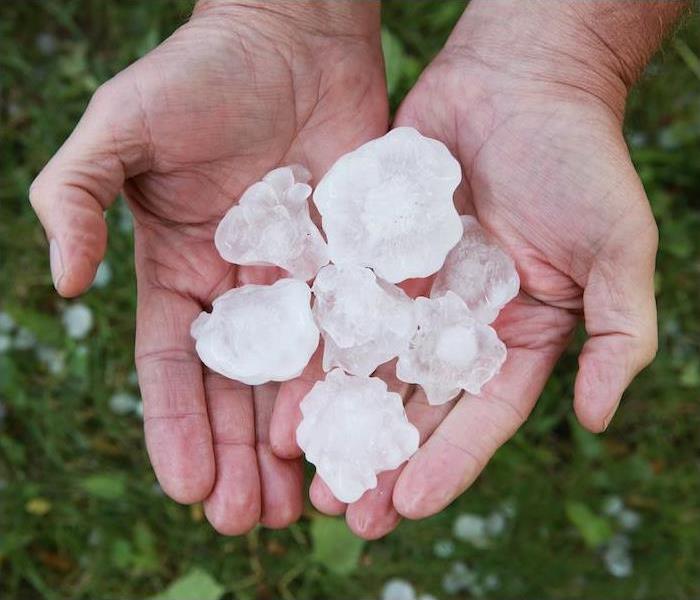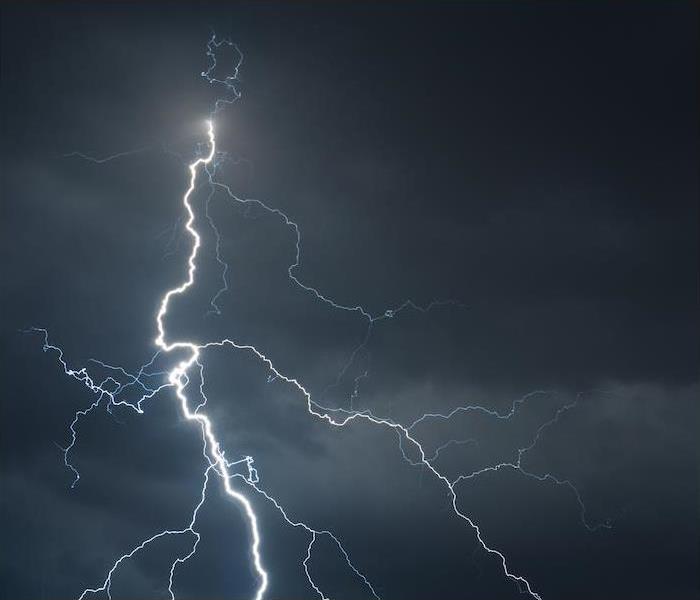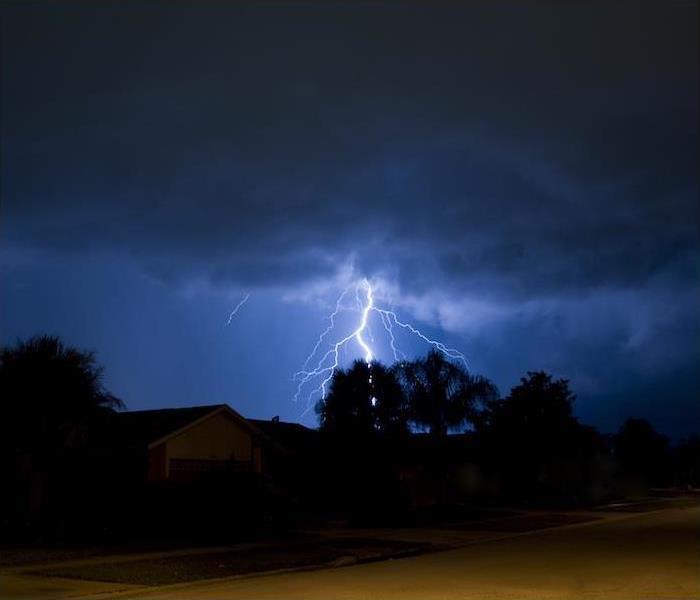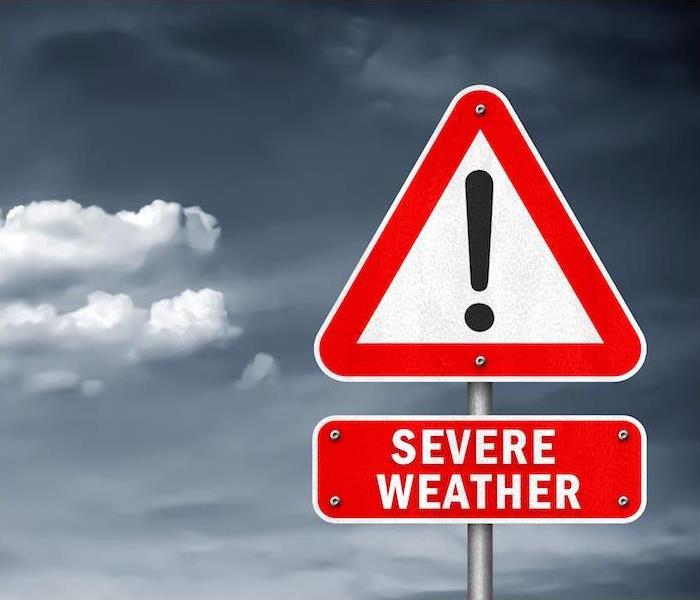Archived Storm Damage Blog Posts
Understanding Damage From Severe Storms | SERVPRO® of Garden Grove East/Anaheim Central
3/22/2022 (Permalink)
Thunderstorms can sometimes be a daily occurrence during the spring and summer depending on where you live in the United States. But they also bring the opportunity for storm damage.
Do you know about the different types of damage that can be caused by thunderstorms?
<h4familiar-with-thunderstorms">Get Familiar With Thunderstorms
First, let’s learn a bit about thunderstorms. We can experience some 16 million thunderstorms throughout the world each year. Here in the United States, it’s not unusual to see 100,000 thunderstorms annually, with 10% of those reaching severe status.
The necessary conditions for a thunderstorm to develop are moisture and rising unstable air accompanied by a “lifting” mechanism, which could be caused by hills or mountains that force air to rise, or where warm/cold or wet/dry air bump together, causing a rising motion.
There are three distinct life cycle stages for a thunderstorm—the developing stage, the mature stage and the dissipating stage. The mature stage is what produces hail, heavy rain, frequent lightning, strong winds and tornadoes.
<h4types-of-damage">Differing Types of Damage
While thunderstorms possess many different dangers, a top risk is the possibility of flying debris.
Wind speeds/gusts in a severe thunderstorm can exceed 57.5 mph—enough to cause damage to your property.
Random items in your yard that would seem the least threatening can turn into projectiles. You should take care to make sure items in your yard are secured or well-maintained if there is a threat of storms. This includes things like tree branches, gravel, mailboxes, fencing, lawn furniture, potted plants and garbage cans, which are all possible projectiles during a high wind situation.
There are many other types of damage thunderstorms can be responsible for besides wind damage:
Lightning damage. A lightning strike can not only pose a fire hazard, but also travel through your home’s wires and fry anything that is plugged in.
Tornado damage. The fact that tornadoes can reach upward of 200 mph wind speeds is scary enough, but with them comes the chance for a large amount of damage in a short period of time.
Hail damage. Coming in at $1 billion in damages yearly, hail is nothing to underestimate. It can damage crops, vehicles and building structures.
Flood damage. Floods are capable of damaging structures, tearing trees out of the ground and sweeping things away.
If a thunderstorm has resulted in damage to your home or business, know that the team at SERVPRO® of Garden Grove East/Anaheim Central is available 24⁄7 to help with cleanup and restoration.
Summer Storm Awareness | SERVPRO® of Anaheim Central/Garden Grove East
3/21/2022 (Permalink)
Summer is around the corner and some are looking forward to going to the beach or pool, Others may be looking forward to vacations and long days with ample sunshine are the norm for us southern Californians. But beware, the occasional thunderstorm can pop up!
The conditions are ripe for summertime thunderstorms because the moist air meets the rising warm air.
In Anaheim, we can expect moderate heat and humidity in summer. But that doesn’t mean we can let our guard down in case those occasional thunderstorms emerges.
Be ObservantSummer storms should always be treated with the respect they deserve. Never underestimate the power of a thunderstorms should you receive an alert from the local meteorologist.
Pay attention to storm alerts and consider getting an NOAA Weather radio. If storms are predicted, consider postponing outdoor activities.
During thunderstorms, flooding is possible and not always predictable. If storms are likely, plan to stay home and off of the roads.
High winds can break tree limbs and throw objects that are not tied down. A good preventive measure is to trim weak and dead branches and bring outside furniture inside.
Caution during thunderstorms is always a best practice. Dozens of people die each year in storm-related events. Don’t take them for granted.
Take Storm Precautions
If you hear thunder, then stay indoors. You can’t have thunder without lightning! Lightning has been known to strike 10 miles from the closets storm.
Avoid showering or bathing during a storms, and you might consider unplugging expensive electronics should lightning be close.
Have an emergency kit made before you need it and know evacuation routes in case that becomes a necessity.
When we experience heavy storms in Anaheim, flash flooding is likely to occur. Avoid all flood water if possible, and do not drive through a water-covered road. You can’t tell if the road has washed away, and it doesn’t take much rushing water to sweep you off your feet or to even move your car.
There are any number of dangers that can come into play in a thunderstorm, and it’s always best to be cautious and put things on hold until storms safely pass. If storms cause damage to your home or business, SERVPRO is on the line, ready to make things right again.
How a Thunderstorm Can Put People in Harm’s Way | SERVPRO® of Anaheim Central/Garden Grove East
7/30/2021 (Permalink)
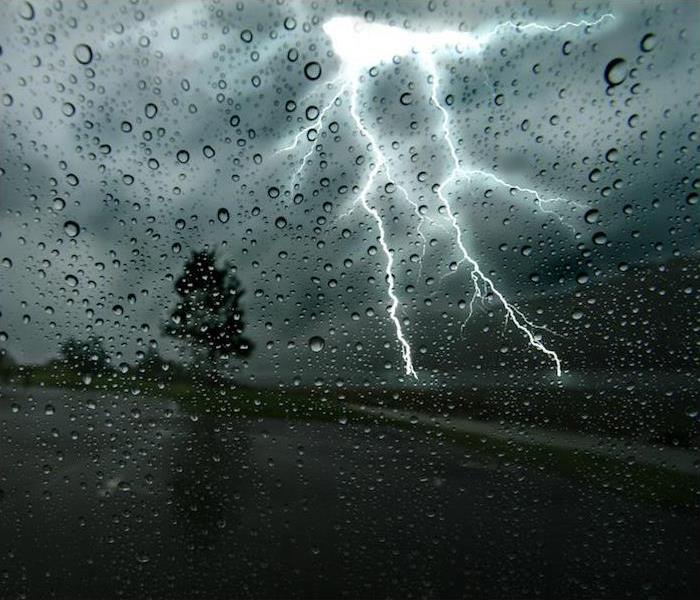 Learn how to stay out of harm's way during a thunderstorm.
Learn how to stay out of harm's way during a thunderstorm.
When warmer weather moves in, it can often bring storm fronts with it. While thunderstorms are a fairly regular occurrence during the hotter months of the year, their frequency should never lead to complacency about the threat that they pose.
While many thunderstorms come through the area without consequence, because of the dangerous elements they contain, there is always a potential for injury or property damage present.
Any time a weather front contains thunder and lightning, it is called a thunderstorm—and all thunderstorms contain both of these elements, even if you do not see lightning or hear thunder. When there is large hail (over one inch) and straight-line winds of 58 miles per hour, a weather front will be classified as a severe thunderstorm, which creates even more potential for harm.
The Dangerous Elements a Thunderstorm Contains
Damage and injury from lightning strikes. Lightning strikes are extremely dangerous, and because they are an element of every single thunderstorm, it is highly likely that one will strike during every storm. Lightning is responsible for at least 300 bodily injuries every year, which does not include the property damage they can cause due to felled trees and fires. Even if it is not visible, any time you can hear thunder, there is lightning in the vicinity.
Property damage due to hail. Hail is not only a frightening thing to experience, but it can also be extremely dangerous. Large hail is extremely loud when it falls and can cause serious injury. If a person does not have adequate shelter, hail can cause major harm. It is also known to cause property damage, leading to dents in cars, damage to buildings’ roofs and impacts in a home’s siding—which can also increase the possibility of water damage.
Harm from flash flooding. Many people assume that flooding can only happen in known floodplain areas, but flash flooding can truly happen anywhere. Between storm drains being overwhelmed to ditches getting backed up, heavy rainfall can cause a flash flood nearly anywhere. Flash flooding is extremely dangerous, as a few inches of water can knock a person off their feet or carry a car away, so never go anywhere near floodwater.
Thunderstorms are dangerous and can cause significant damage to homes or commercial spaces. If you have damage due to a thunderstorm, you can count on us to help. Contact us 24⁄7 for more information about our storm restoration practices.
What to Look for When Choosing a Storm Restoration Provider | SERVPRO® of Anaheim Central/Garden Grove East
6/8/2021 (Permalink)
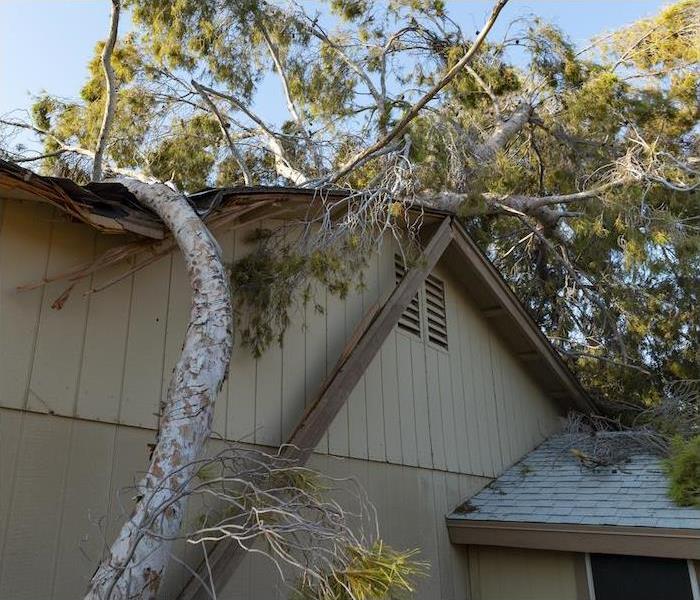 Storms can be scary, we can help.
Storms can be scary, we can help.
Storms are never an enjoyable event to endure, and if they cause damage to your home or business, they are a source of even more added stress. Storms have grown more severe with time, which is why we always recommend knowing exactly how you will handle damage in advance in case it ever comes your way.
When it comes to handling damage to your home or commercial property, the right restoration company will make all the difference in the way the process goes. The company you choose will be in charge of handling every aspect of your damages, so working with one that has your best interests in mind is so important.
Picking Your Storm Restoration Company
Consider what their reputation is. Just like with any other service you would get for your home, doing your research on a restoration provider is so important. There are many scams that are common in areas that have recently been hit by storms, so finding a restoration company like us that is both well-respected in the area and as a restoration provider is so important.
Be sure they can handle any spikes in demand. When a storm or other weather event impacts an entire neighborhood, there will be a spike in demand for restoration—and finding a company that can handle that is vital to getting the best service possible. When we need backup or more resources, we can get in touch with SERVPRO® partners throughout the country to get the workforce we need to match the demand.
Take note of what their hours are. There is no schedule that severe weather follows, and in our experience, it often strikes at the most inconvenient time. No matter what hour you sustain damage to your home, you can be certain that we will be here to help you. You can get in touch with us any time of the day or night, and we will gather all your information and begin formulating a response so your damage can be handled as soon as possible.
When you have damage from a storm to your home or commercial building, you can always depend on us to handle it. Contact us at any hour to see our exceptional service in action.
Memorize These Safety Tips Regarding Summer Storms | SERVPRO® of Garden Grove East/Anaheim Central
2/19/2021 (Permalink)
Longer days and higher humidity means that thunderstorms are far more likely to break out—and even if they are just quickly passing showers, they should be taken seriously.
Any storm that produces thunder also produces lightning and can lead to hail and high winds, so understanding how to stay safe no matter where a storm catches you can help you protect yourself.
Stay Safe From Summer Storms Anywhere
Know your options for shelter. If you are at home and know that a storm is on the way, staying put is generally your best bet for staying safe. Unfortunately, that will not always be the case. If you are out and about when a storm draws near, your car is not a bad place to take shelter as long as you park safely, turn off the engine and avoid touching metals in the vehicle.
Practice electrical safety. Lightning will often travel through a building’s wires as it heads toward the ground, creating a power surge that can travel up the cords of anything that is plugged in. To avoid damage to your electronics and the harmful sparking that can result, install surge protectors at home and in your office space and unplug things entirely if you have time.
Avoid direct contact with concrete. While it may feel like a concrete structure is the safest place you can be, concrete poses its own hazards despite being extremely structurally sound. Most concrete for floors and walls is poured around metal bracing materials, so concrete can actually disperse an electrical charge if struck by lightning. Avoid touching concrete if possible during a storm.
Stay indoors for at least 30 minutes. When your summer fun is interrupted by a thunderstorm, you will want to get back to what you were doing as soon as the skies clear. However, experts recommend waiting at least a half hour before you resume any activities to be on the safe side, as lightning has been known to strike as much as 25 miles away from the storm clouds.
If your home sustains damage due to a storm, you can count on us to help. Contact us at any hour to learn more about our storm restoration process.
Tips to Give Your Safety a Boost When Severe Weather Is in the Forecast | SERVPRO® of Garden Grove East/Anaheim Central
2/9/2021 (Permalink)
Though severe weather can be quite a regular occurrence in the spring and summer months, it is important to take every instance of it seriously. Any storm can cause damage to people and their property, leaving devastation and destruction in its wake.
Therefore, it is important to do what you are able to in advance in order to increase your personal safety in case of severe weather. Understanding what common weather alerts refer to, stocking your household with disaster supplies and having multiple ways to tune into emergency broadcasts can all give your storm safety a boost.
Understand What Common Weather Alerts Refer To
Having an understanding of severe weather watches and warnings will help you stay informed and know how to prepare when these alerts are dispatched. When a severe weather watch occurs, it means that severe weather is a possibility as a result of current weather readings, but no action (aside from attentiveness) is required. If a severe weather warning is issued, that means that severe weather has been picked up on radar and thus poses an imminent threat to the nearby area.
Stock Your Household With Disaster Supplies
When a severe weather warning is dispatched from local officials, you want to be sure that you stay put and stay safe until the storm passes. That is why you should always stock your household with disaster supplies so you can safely hold out until the worst of the weather passes. Nonperishable foods, adequate amounts of water, flashlights and batteries are all good things to include. Additionally, have a designated spot to head to during severe weather—preferably on the ground floor and away from any windows that could shatter during high winds.
Have Multiple Ways to Tune Into Emergency Broadcasts
While most of us rely on our smartphones to get information about the weather, this method can have some drawbacks and is not reliable during severe weather. Because cell reception can be spotty during severe storms and electricity is often unreliable, make sure you have multiple ways to get alerts that do not depend on the traditional power grid. A non-electric weather radio powered by batteries or manually is often a good solution for this.
If your home has been impacted by storm damage, we are here for you. You can contact us 24⁄7 to get a quick response to your home’s damages.
Avoid Storm Damage With These Weatherproofing Tips | SERVPRO® of Garden Grove East/Anaheim Central
4/9/2020 (Permalink)
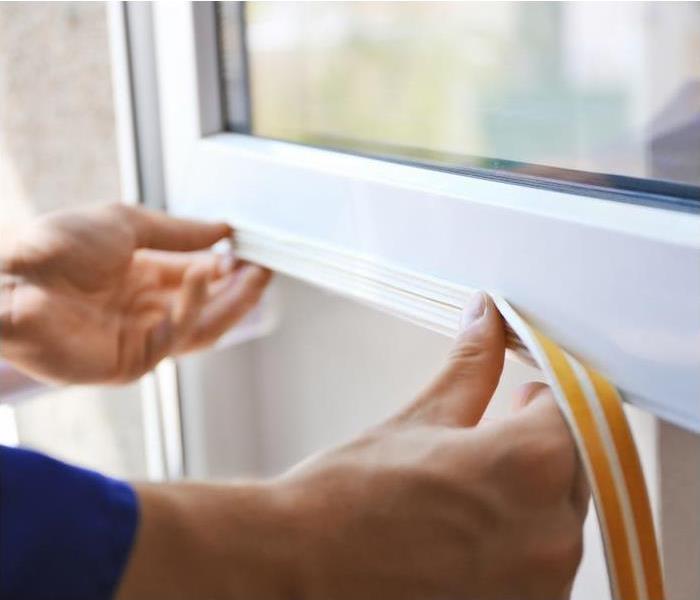 Weatherproof your home today with these easy tips.
Weatherproof your home today with these easy tips.
Though every house is built with resisting weather in mind, as age takes its toll, it is expected that homeowners will have to make updates to keep it resistant. Severe weather can lead to serious damage to a defenseless home, and with around half of insurance claims being a result of weather, it is something that is wise to take seriously.
Fortunately, taking measures to increase your home’s weatherproofing is something that most people can do themselves as a weekend project that does not require a significant cost investment. Here are our top weatherproofing tips to keep your home protected:
Tips to Protect Your Home From Storm DamageKeep Your Shingles in Shape
Any time it rains, there is potential for a roof leak to develop and they can start for many different reasons. To reduce the chances of experiencing a roof leak, doing a visual check on your shingles can go a long way. Replace any shingles that are cracked or loose before the next rainstorm to reduce the chances of a roof leak starting up.
Beat the Weather With Weatherstripping
Adding weatherstripping around exterior doors and windows is one of the best things you can do for your home. Not only will it keep water leaks out, but it can also save on energy costs by keeping outside air from seeping into the home. Weatherstripping is one of the easiest and most cost-effective ways to make sure your home is sealed against the elements.
Gut Debris From Your Gutters
As leaves accumulate in gutters, they can lead to blockages and dams that cause water damage during heavy rains. It is advised to clean gutters out at least twice each year, and even more if you have a good bit of tree coverage. In between, look for visual signs of issues when it rains—water spilling over the sides, downspouts that are not draining and standing water are all indicators that there might be an issue.
Pick the Right Paint
Giving your home a paint upgrade is about more than just increasing its visual presence these days. There are many high-tech paints that are designed to increase your home’s resistance to the elements. From UV blockers to prevent wear and tear and waterproof coatings to keep the materials underneath dry, paint can go a long way in protecting your home.
If you have issues with storm damage to your home, we are always here to help. Contact us 24 hours a day for a rapid response.
Preparing for Unpredictable Spring Weather | SERVPRO® of Garden Grove East/Anaheim Central
3/26/2020 (Permalink)
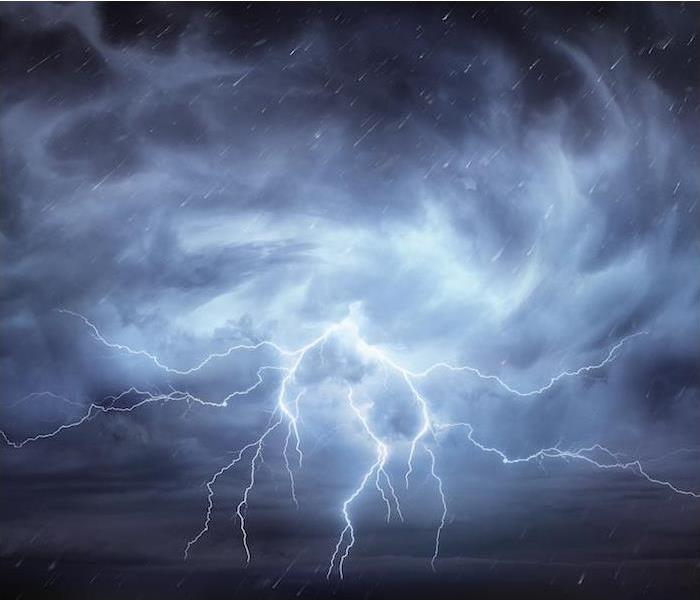 Lightning and thunderstorms may cause damage to your property but know that SERVPRO of Garden Grove East/Anaheim Central is always here to help!
Lightning and thunderstorms may cause damage to your property but know that SERVPRO of Garden Grove East/Anaheim Central is always here to help!
Spring is upon us! While spring brings us more opportunities to enjoy warmer weather, we must also prepare ourselves and buckle up for a bumpy ride from Mother Nature.
Dealing With Mother NatureWith the arrival of spring comes longer days and more sunshine; however, spring also presents the threat of severe weather throughout the country. It’s dealer’s choice this time of year, which means the weather may change at moment’s notice.
Temperatures that can go from warm to cold within hours on the same day can cause a change in the weather.
Thunderstorms become increasingly common throughout the spring and are the main cause of severe weather. A thunderstorm can occur whenever warm, moist air collides with cool, dry air, which is most common in the spring and summer.
In taking a look at natural catastrophe losses in the U.S. for 2017, severe thunderstorms were the most common and produced some of the costliest results. Out of 50 events, there were 85 fatalities and an estimated total of $25.4 billion in overall losses.
With these storms come the threat of floods, high winds and even tornadoes if the conditions are right. It has been found that in modern history, 10% of all violent tornadoes have occurred in March, with April, May and June taking the top spots at 30%, 24% and 15% respectively.
How to Be PreparedAdvanced warning, along with the proper preparation, can improve the overall safety for your family. Although it may not be possible to predict the weather with 100% accuracy, forecasters have the tools available to at least give us an idea of the possibility of severe weather, allowing us to prepare for that weather.
Here are some things you can do to your home to prepare for the chance of severe weather:
- Clear out your home’s gutters, drains and downspouts.
- Trim trees of precarious limbs or branches that could break off in a storm.
- Secure or store outdoor belongings if severe weather is in the forecast.
Having an emergency kit on hand is always advised. These kits should include the following:
- Battery-operated flashlight and NOAA weather radio, with extra batteries for both
- Emergency evacuation or shelter plans
- Important personal info, like telephone numbers of neighbors, family and friends, insurance and property info, numbers for the utility companies, and medical info
- A first-aid kit with things like non-latex gloves, adhesive bandages, tweezers, sterile gauze pads, aspirin packets, adhesive cloth tape and scissors
- 3–5 day supply of bottled water and nonperishable food
- Personal hygiene items
- Blankets or sleeping bag
Despite its unpredictability, there is one thing that always remains true of the spring weather season: It always happens. If your home or business is damaged in a storm, you can depend on SERVPRO® of Garden Grove East/Anaheim Central to get the cleanup and restoration process started fast.
Here’s What Could Cause Water Damage in Your Home | SERVPRO® of Garden Grove East/Anaheim Central
3/26/2020 (Permalink)
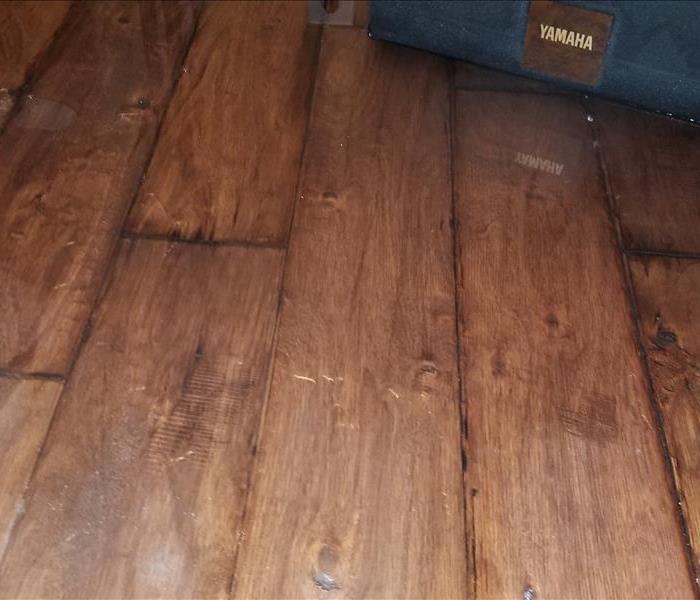 Leading Causes of Water Damage.
Leading Causes of Water Damage.
Water damage can be caused by severe weather, which is what usually comes to mind for many. However, while storms and flooding can cause catastrophic water damage, they are often not the main culprits.
Instead, various items in your home can be responsible for many situations that result in water damage.
Damage Caused by Water
Water damage is something that many homeowners will face as it is the third most common reason a homeowner will file a claim on insurance. Claims filed between 2011 and 2015 had an average payout per claim of $8,861.
It is important to understand the difference between water damage and gradual damage, which can impact insurance claims. Gradual damage is damage that has been happening over time, such as plumbing issues in the walls causing damage to the walls, ceilings or floors, or water damage caused by cracks in the foundation. Unfortunately, gradual water damage is usually not covered by homeowners insurance, while storm-related water damage usually is.
The Usual Suspects
The Insurance Institute for Business & Home Safety (IBHS), has discovered that the leading causes of water damage are as follows:
- Plumbing supply system failures. This would involve frozen pipes that burst due to a buildup in water pressure caused by freezing water or when the supply system material fails and results in a leaking or burst pipe. Plumbing supply system failures are the leading source of residential water losses, according to IBHS, and claims average $5,092 per incident after the deductible. Homes 16 to 40 years of age make up a large group of supply system material failure claims.
- Plumbing drain system failures. These can occur if a sewer drain backs up and overflows into a home or from material performance failures. The IBHS study discovered that 52% of drain system can failures were caused by sewer backups and 37% were related to material performance issues. Moreover, they also found that the average drain system failure resulted in higher claims in southern region states as opposed to the northern region states.
- Toilet failures. Toilets come in second to plumbing supply system failures for residential water loss and these failures are caused by anything from faulty fill valves or clogged drain lines. Toilet failures that happen on the first floor of a home resulted in higher claims than those in basements or upper floors, according to IBHS.
- Water heater failures. If your water heater has reached or passed its life expectancy, the tank begins to deteriorate with rust and corrosion, which can cause leaking or bursting issues. IBHS found that 69% of all water heater failures resulted from a slow leak or sudden burst and, on average, claims were approximately $4,444 per incident following the deductible.
- Washing machine failures. These failures are typically caused by supply hose failures, machines overflowing and drain line failures. Washing machines are one of the top 10 sources of residential water losses. According to IBHS, supply hose failures accounted for over half of all washing machine-related water losses.If your home ever experiences any water damage, the professionals at SERVPRO® of Garden Grove East/Anaheim Central are available to help with cleanup and restoration and make it “Like it never even happened.”
After Destructive Storms, Give Us a Call | SERVPRO® of Garden Grove East/Anaheim Central
3/26/2020 (Permalink)
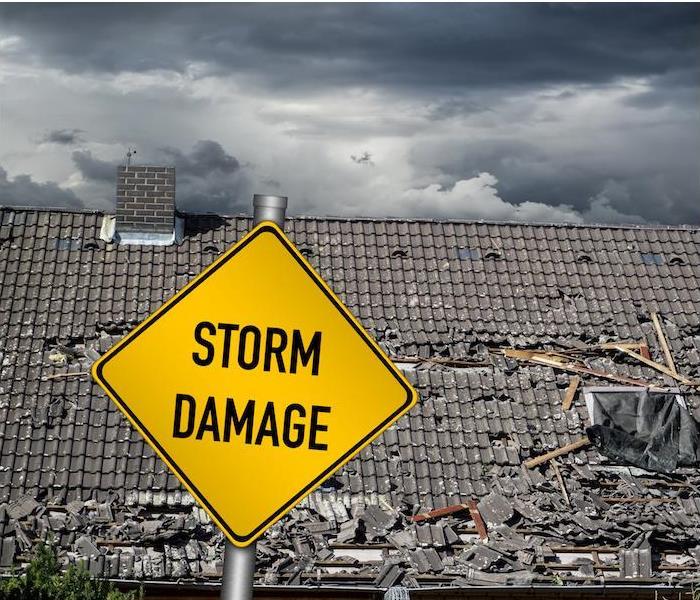 Call SERVPRO® of Garden Grove East/Anaheim Central when destructive storms hit.
Call SERVPRO® of Garden Grove East/Anaheim Central when destructive storms hit.
Though storms are quite common, it is important to never disregard the damage they can lead to. In 2018, homeowners experienced around $2 billion in property losses due to storm damage, and they are some of the most common occurrences that lead to insurance claims
Knowing what to do and who to call after storm damage can help you be more prepared and receive help more quickly. That is why we are here 24⁄7 to answer your call for storm restoration and will take care of your damage with efficiency and quality work.
Why to Call Us After a Destructive Storm- We Won’t Just Help With Some of the Damage
There are many things that can be involved with a storm damage call, and many companies may only be able to help with one or two aspects of it. When you call us, you can be certain that we are fully prepared to handle multiple types of damage, so whether it is structural or moisture-related, we can help you out. - We Make Sure Our Technicians Are Prepared
Because we understand the importance of high-quality work, we invest heavily in our technicians’ training and continued education. We make sure everyone is familiar with the Institute of Inspection Cleaning and Restoration Certification industry guidelines, and we host many seminars and online learning programs to keep everyone informed on the latest techniques. - We Can Help With Any Sized Disaster
Because SERVPRO® is a national brand, we have the best of both worlds—we are a locally owned Anaheim business, but in cases of widespread damage, we are able to call upon other assets in order to provide additional resources and make sure everyone in the community can get the restoration services they need in a timely manner. - We Value Our Good Reputation
We have been helping people with home restoration for many years, and we are all too familiar with the scams that arise in the wake of storms and disasters. Working with an established national company means you will not have to be concerned with the legitimacy or the quality of the work you will receive, as we will prove that our reputation is well deserved.
If you have experienced storm damage or want to learn more, you can call us 24⁄7 for more details.
An Introduction to the 3 Water Classifications | SERVPRO® of Garden Grove East/Anaheim Central
3/1/2019 (Permalink)
Understanding the difference between the types of water involved in water damage can help you better understand how to handle the situation. It is easy to think that all water causing damage is the same, but there are three different classifications of water involved: clean, gray and black.
No matter what type of water is involved in the damage, there is always going to be a cleanup and restoration process that follows. The first and most important step you must take is to remove all the moisture and damp items quickly, so that mold cannot begin to flourish in its ideal environment.
Clean Water
Much like the name says, this water is considered “clean” because it is free from contaminants and will not necessarily be the type to pose an immediate threat to your health. You will generally be dealing with clean water with the following:
- Broken water lines
- Malfunctioning appliances
- Toilet holding tanks
- Snow melt and rainwater
This is the easiest type of water damage to work with, as there will be fewer microbes living in the water, but after 48 hours and following contact with building surfaces, clean water then becomes a category two type of water, “gray” water.
Gray Water
In a gray water damage situation, cleanup and restoration can become a bit more tedious and serious. This is water that may pose a health risk, because it will contain some chemical or biological contamination. Because there is that slight contamination in gray water, it means that it would need to be thoroughly treated before being safe to consume.
Gray water can be a product of dishwashers, aquariums, showers, etc. The 48-hour exposure time applies here, as well, because if gray water is left untreated, it then becomes black water.
Black Water
Black water is the most serious of the three classifications, and the utmost precaution must be taken when dealing with it because it will be highly contaminated by harmful chemicals and biological matter.
This type of water includes floodwaters containing soil and all sewage waters. Sewage is filled with harmful microbes, including bacteria, protozoans, molds, fungi and more—many of these can be harmful to humans.
Some of the diseases that can be transmitted by black water are:
- Cholera
- Typhoid
- Hepatitis
- Gastroenteritis-type illnesses
The rule of thumb here is to remember that when it comes to floods, all water should be considered to be black water since it is picking up all kinds of contaminants along its path.
All of these classifications of water involved in water damage are recognized by the Institute of Inspection, Cleaning and Remediation Certification (IICRC), an organization that certifies and sets the standards for the cleaning and restoration industries. Our technicians all study IICRC standards and best practices in water restoration and are available to help determine the steps to take to get your home back to normal.
It doesn’t matter what type of water has caused damage to your home or business, SERVPRO® of Garden Grove East/Anaheim Central is here to help get the situation under control and make it "Like it never even happened." Don’t hesitate to reach out to us if you need emergency cleanup and restoration services!
Ensuring Your Family Is Prepared for Severe Weather | SERVPRO® of Garden Grove East/Anaheim Central
3/1/2019 (Permalink)
Be prepared! There are steps you should take and safety tips to follow to ensure your family is prepared for various severe weather occurrences. Because even though we may have advance warning for approaching severe weather systems, we can still be caught off-guard at times.
Planning for Severe Weather With Your FamilyOne of the best ways to prepare for weather emergencies is to have an established family emergency plan at the ready.
If your family has put an emergency plan in place, be sure to discuss, practice and review it at the start of each weather season so your family knows exactly what to do.
If you’ve not yet created a family emergency plan, take a look at these considerations when you prepare one:
1. How will emergency alerts and warnings be received?
Thanks to technology today, emergency alerts and warnings are in our pockets, briefcases, backpacks or purses with the use of smartphones equipped with a weather app or Google. This allows you to quickly receive emergency alerts, giving you valuable time to act in a severe weather situation. These warnings and alerts are available over radio and TV in the event you do not have a smartphone.
2. What type of storm shelter is available?
If you live in an area where tornadoes are common, you’ll want to be in the lowest part of your home, like a basement or an interior room on the lowest level that is away from corners, windows, doors and outside walls. Be aware, however, that tornadoes aren’t the only weather circumstance requiring a form of storm shelter, and you can find out more about these situations that call for them by visiting ready.gov.
3. What is your evacuation route?
You should always have evacuation routes mapped out for escape for things such as hurricanes, flooding and fires, which can force you from your home in a hurry. It’s wise to have multiple routes in the event one is impassable, and be sure to take your pets into consideration and find places to stay along the way if you have furry family members taking shelter also.
4. How will the family keep in touch?
Cell phone are a common commodity nowadays, and it is easy to rely on them to keep in touch with your family. But, in some circumstances, that will not be possible.
Cell phone towers can be taken out by the weather, the cell phones can be lost or left behind, and batteries need charging, which will be hard to do when there is no power to recharge them. Your family will need an emergency communication plan in place, as well as a pre-determined safe meeting place so that you can all meet there if separated.
If a storm does cause damage to your home or business, don’t hesitate to call your friends at SERVPRO® of Garden Grove East/Anaheim Central to get the cleanup and restoration process started.
The Impacts Damaging Winds Can Have on Your Property
1/7/2019 (Permalink)
Severe storms bring a variety of concerns, with one being the threat of damaging winds. These winds can come with little to no notice and can be problematic due to long-term structural impacts.
Understanding Damaging Winds
Usually one thinks of tornadoes and hurricanes when they think of damaging winds. However, those are not the only times when they may come into play.
Damaging winds are considered those with wind speeds exceeding 50–60 mph and can be caused by a strong thunderstorm. The term “straight-line” winds is used when differentiating the damage from tornadoes.
Straight-line winds can cause other objects to become projectiles, leading to additional damage. Windows and roofs can take a devastating blow, and if it’s extensive enough, can result in water damage to the home as the outside elements come indoors through damaged windows and roofs.
Anyone living in a thunderstorm-prone area can be at risk from damaging winds, but some structures are more at risk than others. Mobile homes, even when anchored, can sustain extensive damage in wind gusts over 80 mph.
Tips to Help Protect Your Property From Wind Damage
Some ways you can keep your property from sustaining damage from these damaging winds are listed below. Keep the “Two R’s” in mind: reinforce and remove.
Have your garage door professionally reinforced.
Remove or anchor loose furniture and other items such as trash cans and grills on your property that could be tossed by the wind and become projectiles.
Have large or dying trees and branches that could fall on your home be removed by a professional.
Not all high wind situations come with advanced warning. But by following some of the above precautions, you can be ready “just in case.”
Also, if you are building a new home or renovating an older home, be sure the windows, walls and doors are up to code for the weather in your area.
If you ever experience this kind of loss to your home due to damaging winds and resulting water damage, the highly trained specialists at SERVPRO® of Garden Grove East/Anaheim Central are always here to help with the cleanup and restoration of your home.





 24/7 Emergency Service
24/7 Emergency Service